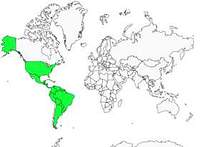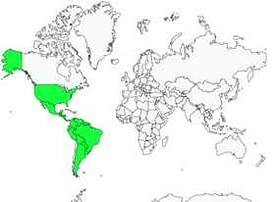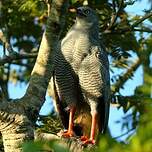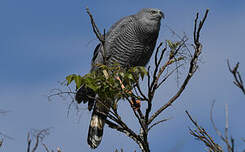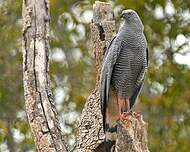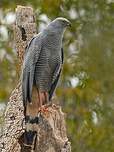Crane Hawk
Geranospiza caerulescens - Buse échasse
Identification
The Crane Hawk (literally Crane Raptor) has a very imaginative name in both languages. Some have linked the Crane Hawk to the African Harrier Hawk due to its hunting style or its plumage, but the filiation is very unlikely and this Crane Hawk is almost certainly a Neotropical raptor. Three groups are recognized: nigra, caerulescens and gracilis. The most recognizable is caerulescens, the bird measuring from 40 to 50cm, and the first visible peculiarity, especially when it is on the ground, is the length of its red-orange legs, which seem to perch our Crane Hawk on stilts. The predominant color is a magnificent gray-blue that covers the whole head, the mantle and the back. The wings have all the upper parts, coverts, scapulars and remiges of the same gray-blue color. When the Crane Hawk is in flight, the under-wing covers are light gray to darken to become black for the remiges, two very clear white bands appear at the limit of the hand and the primary remiges. The chest and abdomen will have the same gray, the lower abdomen will be slightly striped with white and the rectrices black are barred with two very clear white marks. Females are generally larger than males.
Young birds have a different appearance, the crown, the nape, the forehead and the chest are striped with white, the parotic areas are also white. The chest that should become gray-blue is gray and has white marks, generally vertical, the abdomen and lower abdomen are yellowish, as well as the plumage covering the tibiae. The upper coverts are striped with white. The young have the yellow eye circle that will become dark red with age, the eye is black as is the beak.
The peculiarity of the Crane Hawk, which gave its name to the species, are the red orange colored legs and especially the tarsometatarsi which are longer in the Crane Hawk than in other buzzards and which are essential for its particular way of hunting.Of the three recognized groups, nigra is the most differentiated with an adult plumage of black instead of the gray-blue of caerulescens, gracilis remains gray with a chest and belly that will keep white stripes in adults.
Subspecific information 6 subspecies
- Geranospiza caerulescens caerulescens (e Colombia to the Guianas to e Peru and Amazonian Brazil)
- Geranospiza caerulescens livens (nw Mexico)
- Geranospiza caerulescens nigra (Mexico to c Panama)
- Geranospiza caerulescens balzarensis (e Panama to nw Peru)
- Geranospiza caerulescens gracilis (ne Brazil)
- Geranospiza caerulescens flexipes (s Brazil to Paraguay, Bolivia, n Argentina and Uruguay)
Foreign names
- Buse échasse,
- Azor zancón,
- gavião-pernilongo,
- Stelzenbussard,
- odúölyv,
- Langpootkiekendief,
- Poiana zampelunghe,
- grodhök,
- Tranevåk,
- azor krahulčí,
- káně dlouhonohá,
- Tranehøg,
- pitkäjalkahaukka,
- aligot de cames llargues,
- jastrzębiec,
- Журавлиный ястреб,
- セイタカノスリ,
- 鹤鹰,
- tranvråk,
- 鶴鷹,
Voice song and call
Habitat
Behaviour character trait
An outstanding hunter with fierce techniques, the Crane Hawk actually makes use of its very long legs to climb, like an woodpecker sometimes, on all types of trees.
It will plunge its legs and talons into the nests located in the tree holes to search for all possible types of birds and especially nestlings. It is fond of arboreal frogs, raids nests in palm trees, it is known that it attacks on the ground and in flight. It has been seen waiting near natural or man-made fires to swoop in on animals fleeing the fire! The Crane Hawk or the perfect neo-tropical pirate!Dietfeeding habits
Reproduction nesting
The breeding period varies from region to region and between subspecies, occurring from April to June in Mexico, January in Panama, and April in Surinam.
The Crane Hawk chooses a large tree, and builds its nest from branches, creepers and climbing plants, secured with long strands of grass. The interior of the nest is lined with leaves. The couple put on an aerial nuptial display, punctuated by repeated cries, sometimes accompanied by the presentation of gifts of prey. Usually two eggs are laid. Little information is available about incubation and the rearing of the chicks.Geographic range
From southern Mexico, where mainly the subspecies nigra is found, to Central America, and all of South America, including northern Argentina, Bolivia, Colombia, Ecuador, Paraguay, Peru, Uruguay, and of course Brazil; caerulescens in the Pantanal, Matto Grosso, and the Amazon; the subspecies balzarensis is found further east in Brazil. Chile, the Peruvian Andes, and southern Argentina do not host the Crane Hawk; it does not fly high, and can not be observed in Mexico above 700 m.
Threats - protection
Sources of information
- IOC World Bird List (v15.1), Gill, F and D Donsker (Eds). 2025-12-07.
- Vol. 2 - Handbook of the Birds of the World, Josep del Hoyo-Andrew Elliot--Jordi Sargatal
- A Field Guide to the Birds of Brazil, Ber Van Perlo
- A Guide to the Birds of Mexico and Northern Central America, Steve N. G. Howell, Sophie Webb
- Birds of Peru, Thomas S.Schulenberg, Douglas F.Stotz, Daniel F.Lane, John P.O'Neill, Theodore A.Parker III
- BirdLife International, BirdLife International
- ARKive, Christopher Parsons
- Whatbird,
- Wikipédia, Wikipedia, The Free Encyclopedia
- Global Raptor Information Network,
Other sources of interest
 Specification sheet created on
30/07/2023 by Anne et Gabriel Leboff
Specification sheet created on
30/07/2023 by Anne et Gabriel LeboffTranslation by AI Oiseaux.net
© 1996-2025 Oiseaux.net
- Accipitriformes
- Aegotheliformes
- Anseriformes
- Apodiformes
- Apterygiformes
- Bucerotiformes
- Caprimulgiformes
- Cariamiformes
- Casuariiformes
- Charadriiformes
- Ciconiiformes
- Coliiformes
- Columbiformes
- Coraciiformes
- Cuculiformes
- Eurypygiformes
- Falconiformes
- Galliformes
- Gaviiformes
- Gruiformes
- Leptosomiformes
- Mesitornithiformes
- Musophagiformes
- Nyctibiiformes
- Opisthocomiformes
- Otidiformes
- Passeriformes
- Pelecaniformes
- Phaethontiformes
- Phoenicopteriformes
- Piciformes
- Podargiformes
- Podicipediformes
- Procellariiformes
- Psittaciformes
- Pterocliformes
- Rheiformes
- Sphenisciformes
- Steatornithiformes
- Strigiformes
- Struthioniformes
- Suliformes
- Tinamiformes
- Trogoniformes


